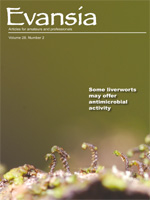The goal of this study was to establish the presence of antimicrobial agents in a liverwort, Riccia nigerica, and to compare the effect with standard drugs. The fresh plant was crushed and extracted by soaking with acetone. Extract filtrate was fractionated and purified by silica gel chromatogram. The absorbent wavelength of isolated fractions was measured by photospectrometer. Antimicrobial activity of R. nigerica was studied against four test bacteria (Bacillus subtilis, Pseudomonas aeruginosa, Shigella dysenteriae, and Staphylococcus aureus) and four test fungi (Aspergillus flavus, A. niger, Penicillium spp., and Rhizopus spp. ) using acetone as extracting solvent and disc diffusion method for screening. Antimicrobial activity was measured in terms of the zone of inhibition (mm) in bacteria and growth of mycelia in fungi. Acetone extract of R. nigerica gave five absorbent spectra fractions. The crude extract exhibited a strong significant antibacterial and antifungal activity. This activity was significantly lower than that of the standard drug (n=9, p ≤ 0.05, 2 -tailed). About 25% of the test microbes showed resistance to the extract and the drug activities. Acetone was found to be an effective extracting solvent. The extract of R. nigerica displayed significant antimicrobial activity, a possible alternative to drugs.
How to translate text using browser tools
1 May 2011
Antimicrobial Activity of the Indigenous Liverwort, Riccia nigerica Jones, from Southwestern Nigeria
O. A. Ariyo,
O. O. Shonubi,
O. O. Oyesiku,
A. O. Akande
ACCESS THE FULL ARTICLE

Evansia
Vol. 28 • No. 2
May 2011
Vol. 28 • No. 2
May 2011
Absorbance spectra
acetone
bryophyte
Tropical rain forest




